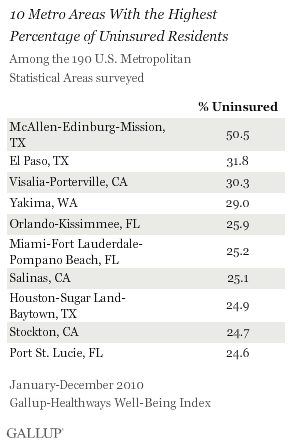WASHINGTON, D.C. -- Half of adults living in the McAllen-Edinburg-Mission, Texas, metro area were uninsured in 2011, the highest percentage in 190 U.S. metro areas Gallup and Healthways surveyed that year. This percentage is about 10 times the rates found in four Massachusetts metro areas, which also have the lowest uninsured rates among metro areas nationwide.


Nine of the 10 metro areas where residents were most likely to be uninsured last year were in Texas, California, and Florida -- three states with large Hispanic populations. Gallup has consistently found that Hispanics are among the most likely in the U.S. to be uninsured since it started tracking health insurance status in January 2008. The McAllen-Edinburg-Mission metro area has by far the largest Hispanic population in the nation: 90.6% in 2010 according to the U.S. Census Bureau. An average of 49% of residents is Hispanic in the 10 metro areas with the highest uninsured rates, compared with 8.3% in the 10 areas with the lowest rates.
Nationwide, 17.1% of Americans lacked health insurance in 2011. The 2011 metro area findings are a subset of Gallup's 2011 Daily tracking data set of more than 350,000 U.S. adults. Gallup categorizes U.S. metro areas according to the U.S. Office of Management and Budget's definitions for Metropolitan Statistical Areas (MSAs) and reports on all MSAs for which there are a minimum of 300 interviews available. Each MSA sample is weighted to ensure it is demographically representative of the population of that local area.
The metro area results reflect what Gallup and Healthways find at the state level -- Texas residents are the most likely in the nation to be uninsured and those in Massachusetts, where health insurance is required by law, are the least likely. The findings are also similar to past years, with McAllen-Edinburg-Mission residents consistently the most likely to be uninsured.
Bottom Line
As the U.S. Supreme Court this week hears arguments from both sides about the legality of the healthcare legislation President Obama signed into law two years ago, Gallup and Healthways continue to find that health insurance coverage rates vary tremendously across the country. In four major metro areas in Massachusetts, 1 in 20 remain uninsured after former governor and current GOP presidential candidate Mitt Romney helped pass healthcare legislation requiring residents of that state to carry coverage. This is a stark contrast to the one in two adults who lack health coverage in the McAllen, Texas, area. Whether this wide variation in uninsured rates across metro areas persists in the years ahead may depend on the fate of the U.S. healthcare law, including the U.S. Supreme Court ruling, which is set to come in June.
About the Gallup-Healthways Well-Being Index
The Gallup-Healthways Well-Being Index tracks well-being in the U.S., U.K., and Germany and provides best-in-class solutions for a healthier world. To learn more, please visit well-beingindex.com.
Survey Methods
Results are based on telephone interviews conducted as part of the Gallup-Healthways Well-Being Index survey Jan. 2-Dec. 29, 2011, with a random sample of 353,492 adults, aged 18 and older, living in all 50 U.S. states and the District of Columbia, selected using random-digit-dial sampling.
The metro areas referenced in this article are based on the Metropolitan Statistical Areas (MSAs) as defined by the U.S. Office of Management and Budget. In many cases, more than one city is included in the same MSA. The San Jose, Calif., metropolitan statistical area, for example, also includes the smaller nearby cities of Sunnyvale and Santa Clara in addition to San Jose itself. Each respondent is attributed to his or her MSA based on the self-report of his or her ZIP Code, and all metro areas had at least 300 completed surveys in 2011.
Maximum expected error ranges for the MSAs vary according to size, ranging from less than 1 percentage point for the largest cities represented to ±6.5 percentage points for the smallest.
Interviews are conducted with respondents on landline telephones and cellular phones, with interviews conducted in Spanish for respondents who are primarily Spanish-speaking. Each sample includes a minimum quota of 400 cell phone respondents and 600 landline respondents per 1,000 national adults, with additional minimum quotas among landline respondents by region. Landline telephone numbers are chosen at random among listed telephone numbers. Cell phone numbers are selected using random-digit-dial methods. Landline respondents are chosen at random within each household on the basis of which member had the most recent birthday.
Samples are weighted by gender, age, race, Hispanic ethnicity, education, region, adults in the household, and phone status (cell phone only/landline only/both, cell phone mostly, and having an unlisted landline number). Demographic weighting targets are based on the March 2010 Current Population Survey figures for the aged 18 and older non-institutionalized population living in U.S. telephone households. All reported margins of sampling error include the computed design effects for weighting and sample design.
In addition to sampling error, question wording and practical difficulties in conducting surveys can introduce error or bias into the findings of public opinion polls.
For more details on Gallup's polling methodology, visit www.gallup.com.
